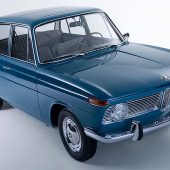The Alpine A110, also known as Berlinette, was unveiled at the Paris Motor Show in 1962. The new vehicle featured the steel backbone frame, glass-fiber polyester bodywork and offset rear-mounted engine. It also used parts from Renault production models, particularly the R8. It was thus a powerful and efficient model, featuring all the improvements made to Alpine models over the years. The Alpine A110 did, however, feature one innovation: the 4-cylinder Renault engine with five bearings. To make room for it, the rear end of the vehicle had to be made bigger. This gave the A110 an “aggressive” style that remained its hallmark.
Drivers had to shoehorn themselves into the minuscule cabin and squeeze their legs into the tunnel as best they could. Only then could they experience the joys of driving this lively sports model. The light weight and handling qualities of the Berlinette meant it was perfectly suited for motorsport. As well as being fun to drive, the cars were favourites with the fans, who often saw them cornering hard at lurid angles. In addition to the works team, the car was also raced by many private teams.

Alpine A110 was a successful rally car right from the start. José Rosinski took the first win for the A110 at the 1963 Rallye des Lions. The remainder of the season followed this trend, with exploits including a win for Jacques Cheinisse on the Rallye d’Automne. In the years that followed, a number of ‘privateer drivers achieved success at national and international level ahead of much more powerful cars from well-established brands. In 1967 Alpine became Alpine-Renault. The new drivers for the works teams were Gérard Larrousse, Jean-Claude Andruet and Jean-Pierre Nicolas. They were joined by many others, including Bernard Darniche in the private teams. In 1970 the Berlinette 1600S was homologated for Group 4, which finally allowed the car to fight on almost equal terms with more powerful competitors. After the season, Jean-Claude Andruet was crowned French and European Champion.
In 1971 Ove Andersson won the Rallye Monte-Carlo. Thérier finished second and Andruet third. Andersson also took the win in Italy against the flotilla of Fiats and Lancias dispatched to beat him. He subsequently triumphed on the Austrian Alpine Rally and on the Acropolis, securing the international title for Alpine. Jean-Pierre Nicolas won the French Championship.

In 1972 the 1600cc engine was replaced by a more powerful 1800cc unit. Jean-Claude Andruet dominated the Tour de Corse. Numerous wins followed, shared between the team’s drivers. Darniche was crowned French Champion at the end of the year, while Jean-Luc Thérier claimed the Rallye des Cévennes driving a turbocharged 1600cc version.
The 1973 season began with victory for Andruet on the Rallye Monte-Carlo, followed home by four other Alpines. In Portugal, Thérier and Nicolas scored a one-two. On the Rallye du Maroc, Darniche was unbeatable. And the rest of the season followed the same trend. Alpine won the inaugural World Rally Championship title and Jean-Luc Thérier was crowned French Champion. 1973 was the climax of the A110’s racing career. After the A110 was retired by the works team, it was still raced by many privateer drivers.










